Orioles are among the most vibrant birds you can welcome into your backyard. Their bright colors and unique feeding habits make them a joy to watch. To attract them successfully, specialized feeders designed for their needs are essential.
These birds prefer nectar, jelly, and fruit, so feeders with reservoirs, jelly cups, or fruit skewers work best. Orange-colored designs are highly effective since orioles are naturally drawn to this shade. Placement matters too—position them near trees or shrubs for safety while avoiding direct sunlight to keep nectar fresh.
Durable materials like recycled plastic or metal ensure longevity, and features like bee guards help manage pests. Setting up feeders in mid-April to mid-May aligns with their migration, increasing your chances of sightings.
Key Takeaways
- Orioles prefer orange feeders with nectar reservoirs, jelly cups, or fruit holders.
- Place feeders near protective cover but away from direct sunlight.
- Durable materials like plastic or metal improve feeder lifespan.
- Set up feeders between mid-April and mid-May for best results.
- Regular cleaning prevents spoilage and keeps birds healthy.
Understanding Orioles and Their Habits
These striking birds captivate birdwatchers with their bold hues and unique behaviors. To attract them effectively, knowing their regional preferences and seasonal movements is key.
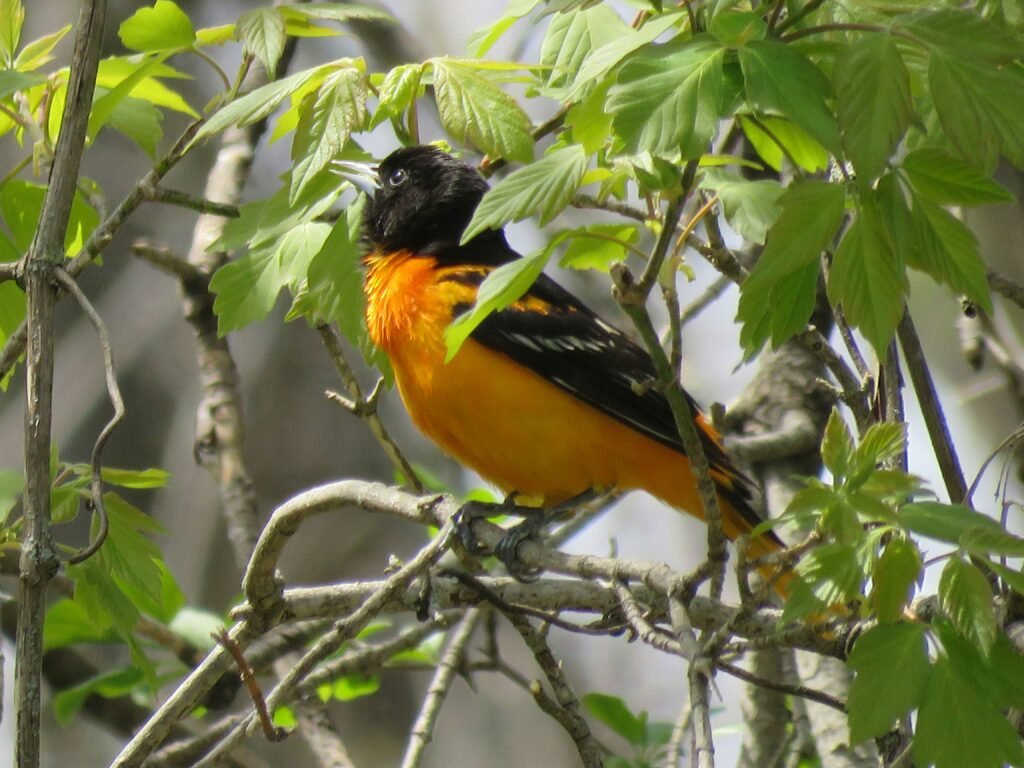
Common Oriole Species in the U.S.
Five species dominate backyards across the country. Baltimore Orioles thrive in the eastern and central U.S., often wintering in the Caribbean. Bullock’s Orioles claim the western states, with some staying in Mexico year-round.
Southwestern regions host Hooded and Scott’s Orioles, which nest in palm trees and readily visit nectar feeders. Orchard Orioles, though widespread, rarely use feeders and depart earlier than others.
Migration Patterns and Seasonal Behavior
Most orioles return to the U.S. by early spring, with Baltimore and Bullock’s arriving between March and April. Hybrids frequently appear where their ranges overlap in the central U.S..
By late summer, many head south, though Scott’s Orioles linger longer in the southwest. Timing feeder setup to match these patterns boosts sightings.
Why Attracting Orioles Requires Special Care
Bringing these colorful birds to your yard takes more than just hanging a feeder. Their distinct habits and preferences demand attention to detail for success.
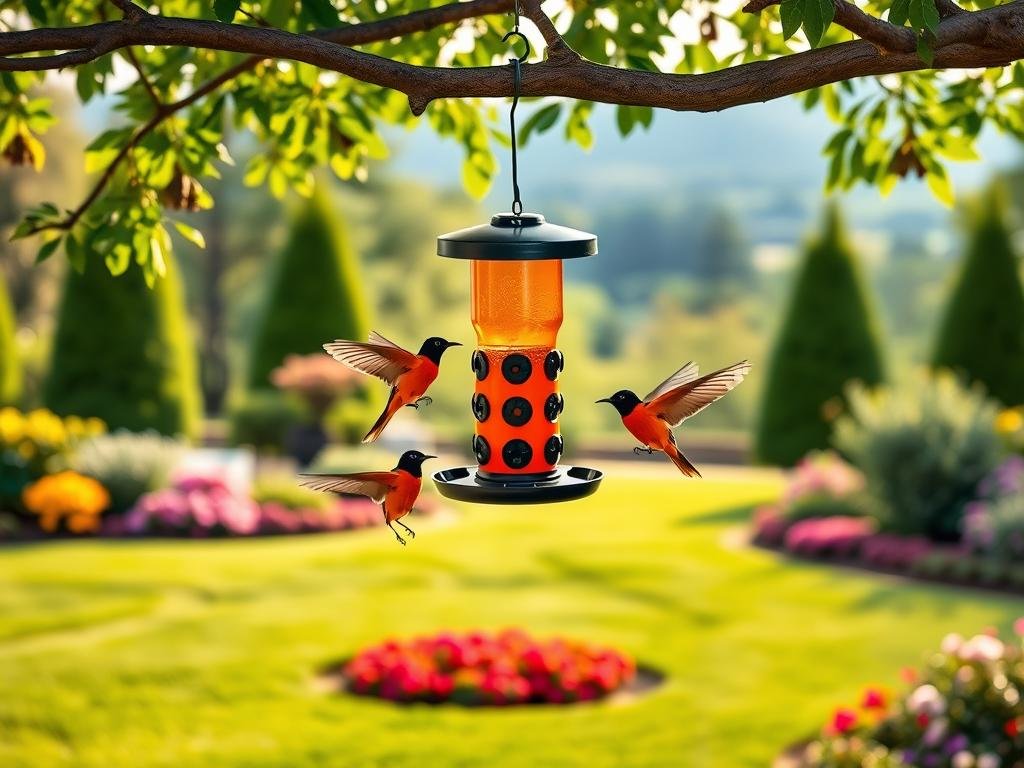 oriole feeder hangs from a sturdy tree branch, its unique design attracting the attention of a pair of curious orioles. The birds flutter around the feeder, their graceful movements captured in a soft, natural lighting that bathes the scene in a warm, golden glow. The background features a faint, blurred landscape, allowing the viewer to focus on the delicate interaction between the orioles and their specialized feeder. The overall composition conveys a sense of tranquility and harmony, highlighting the importance of providing the right food and setting to successfully attract these beautiful, sought-after songbirds." class="wp-image-475" title="A manicured backyard with a lush, verdant lawn and flourishing flower beds. In the center, a vibrant orange and black oriole feeder hangs from a sturdy tree branch, its unique design attracting the attention of a pair of curious orioles. The birds flutter around the feeder, their graceful movements captured in a soft, natural lighting that bathes the scene in a warm, golden glow. The background features a faint, blurred landscape, allowing the viewer to focus on the delicate interaction between the orioles and their specialized feeder. The overall composition conveys a sense of tranquility and harmony, highlighting the importance of providing the right food and setting to successfully attract these beautiful, sought-after songbirds." srcset="https://yourbirdbuddy.com/wp-content/uploads/2025/03/A-manicured-backyard-with-a-lush-verdant-lawn-and-flourishing-flower-beds.-In-the-center-a.jpeg 1024w, https://yourbirdbuddy.com/wp-content/uploads/2025/03/A-manicured-backyard-with-a-lush-verdant-lawn-and-flourishing-flower-beds.-In-the-center-a-300x225.jpeg 300w, https://yourbirdbuddy.com/wp-content/uploads/2025/03/A-manicured-backyard-with-a-lush-verdant-lawn-and-flourishing-flower-beds.-In-the-center-a-768x576.jpeg 768w" sizes="(max-width: 1024px) 100vw, 1024px" />
oriole feeder hangs from a sturdy tree branch, its unique design attracting the attention of a pair of curious orioles. The birds flutter around the feeder, their graceful movements captured in a soft, natural lighting that bathes the scene in a warm, golden glow. The background features a faint, blurred landscape, allowing the viewer to focus on the delicate interaction between the orioles and their specialized feeder. The overall composition conveys a sense of tranquility and harmony, highlighting the importance of providing the right food and setting to successfully attract these beautiful, sought-after songbirds." class="wp-image-475" title="A manicured backyard with a lush, verdant lawn and flourishing flower beds. In the center, a vibrant orange and black oriole feeder hangs from a sturdy tree branch, its unique design attracting the attention of a pair of curious orioles. The birds flutter around the feeder, their graceful movements captured in a soft, natural lighting that bathes the scene in a warm, golden glow. The background features a faint, blurred landscape, allowing the viewer to focus on the delicate interaction between the orioles and their specialized feeder. The overall composition conveys a sense of tranquility and harmony, highlighting the importance of providing the right food and setting to successfully attract these beautiful, sought-after songbirds." srcset="https://yourbirdbuddy.com/wp-content/uploads/2025/03/A-manicured-backyard-with-a-lush-verdant-lawn-and-flourishing-flower-beds.-In-the-center-a.jpeg 1024w, https://yourbirdbuddy.com/wp-content/uploads/2025/03/A-manicured-backyard-with-a-lush-verdant-lawn-and-flourishing-flower-beds.-In-the-center-a-300x225.jpeg 300w, https://yourbirdbuddy.com/wp-content/uploads/2025/03/A-manicured-backyard-with-a-lush-verdant-lawn-and-flourishing-flower-beds.-In-the-center-a-768x576.jpeg 768w" sizes="(max-width: 1024px) 100vw, 1024px" />Unique Feeding Preferences
Orioles crave high-energy foods after migration. Nectar and grape jelly provide quick fuel, while orange slices offer natural sweetness. Unlike hummingbirds, they need perches since they can’t hover.
Orange-colored feeders grab their attention best. Adding actual orange halves near feeders boosts attraction. Remember, jelly should be limited—it’s a treat, not a meal.
The Importance of Timing
Setting up feeders early is crucial. Place them 2-3 weeks before spring migration starts. Late setups often mean missed visits—orioles stick to known feeding spots.
Cleanliness matters too. Moldy nectar or jelly harms birds, so frequent washing is essential. Quiet spots near trees make ideal locations, as orioles prefer some cover.
For more tips on creating an oriole-friendly yard, explore our detailed guide.
How To Choose The Right Oriole Feeder
Understanding their unique needs ensures success. These birds favor designs that accommodate nectar, fruit, and jelly—all in one convenient spot.
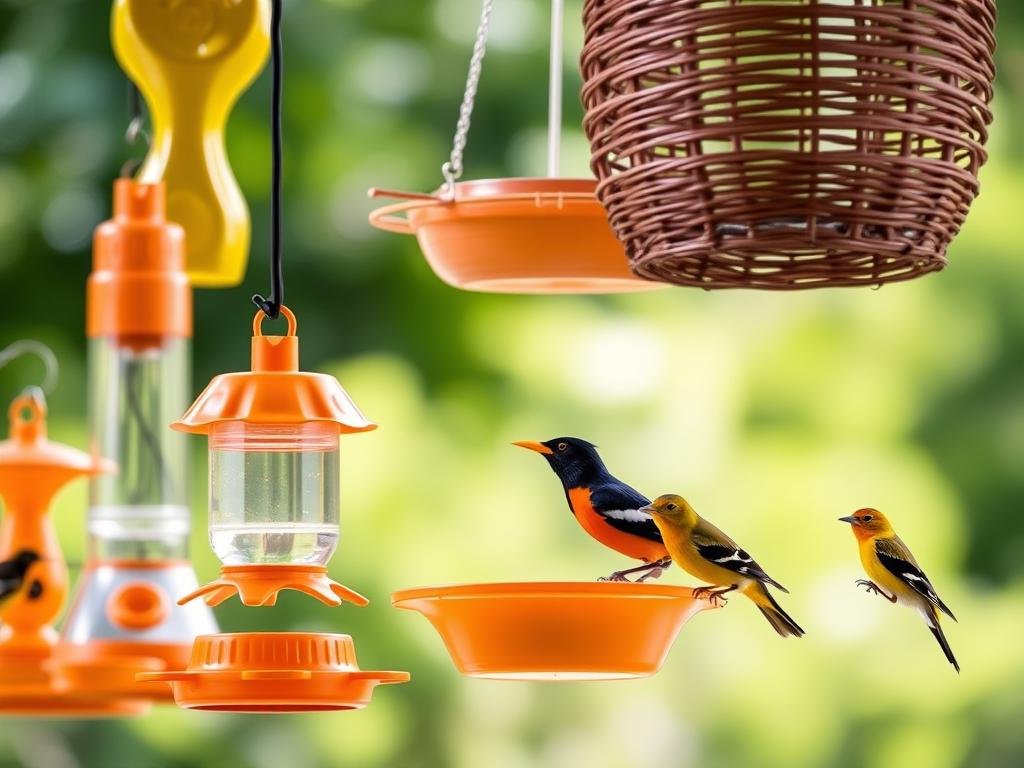
Key Features to Prioritize
Durable materials like recycled plastic or metal withstand weather and frequent use. Look for bee guards and ant moats to protect food from pests.
Feeders with orange accents or built-in spikes for fruit halves boost visibility. Easy-to-clean reservoirs prevent mold and spoilage.
Nectar Feeders vs. Fruit Feeders
Combo designs, like the Duncraft Oriole Delight, offer both nectar wells and jelly trays. Specialized fruit feeders feature spikes for oranges—ideal for attracting orioles early in the season.
For DIY options, repurpose orange halves as jelly holders or modify existing DIY hummingbird feeders with perch additions.
Perches and Accessibility
Unlike hummingbirds, orioles need sturdy perches to grip while feeding. Models from Perky-Pet® include extended perches for comfort.
Place feeders 5–6 feet high near trees for safety, ensuring easy access without overcrowding.
Best Foods to Offer Orioles
Feeding orioles the right foods keeps them returning to your yard. These birds enjoy a mix of sweet and protein-rich options, depending on the season. Below are their top favorites and how to serve them.
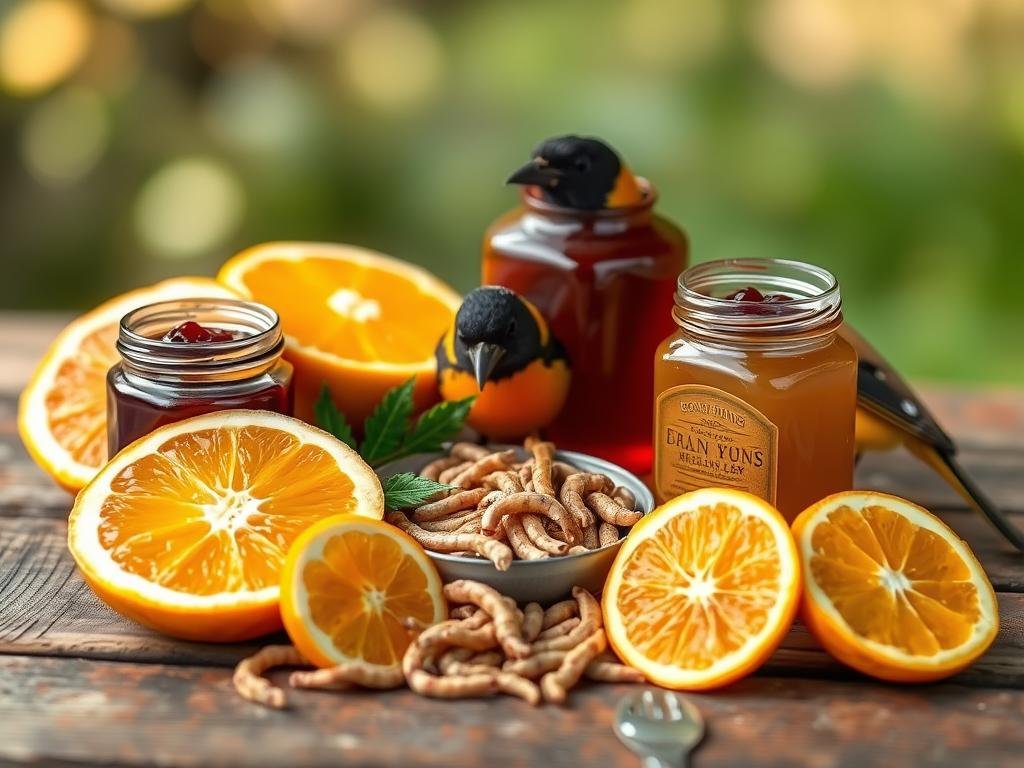
Fresh Fruit and Orange Slices
Orioles prefer ripe, dark-colored fruit, particularly orange halves placed in shallow dishes with water to deter ants. Change orange halves regularly to prevent mold. Pairing them with grape jelly in reused fruit halves boosts attraction.
Grape Jelly and Nectar Recipes
Natural grape jelly without high-fructose syrup is ideal—avoid honey or artificial sweeteners. For nectar, mix 1 part granulated white sugar with 4 parts water, boiled to dissolve sugar and free of dye. Refrigerate unused portions for up to 2 weeks.
Supplementing with Insects
In summer, offer mealworms for protein during nesting season. Suet cakes or insect feeders provide extra nutrients when natural prey is scarce.
| Season | Best Foods | Tips |
|---|---|---|
| Spring | Nectar, oranges | Use bee guards; replace nectar every 3 days |
| Summer | Mealworms, jelly | Limit jelly to 1 tbsp/day; avoid spoilage |
| Fall | Fruit, suet | Remove uneaten fruit to deter pests |
Pro tip: Place feeders near trees for safety, and always keep dishes clean to maintain freshness.
Ideal Feeder Placement for Maximum Attraction
Strategic positioning makes all the difference when inviting these vibrant visitors. Proper placement ensures visibility while keeping birds safe from predators and window collisions.
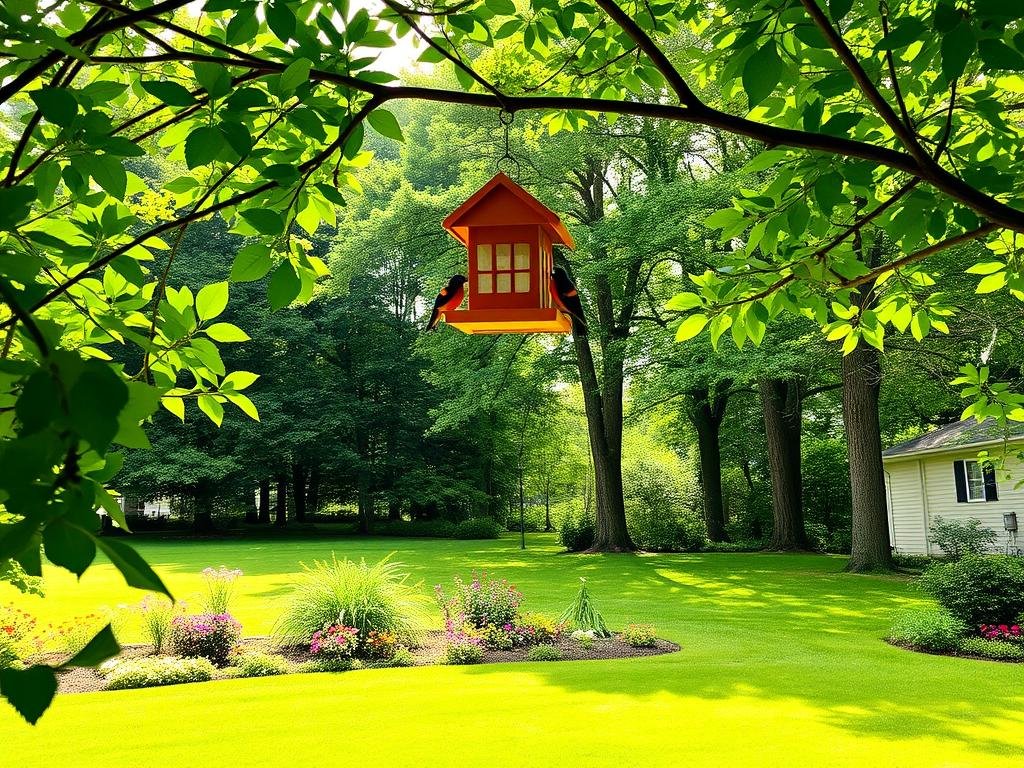
Visibility and Safety Considerations
Start by hanging feeders in open areas using orange ribbons or bright hooks. This helps migrating orioles spot food sources easily.
Mount feeders 5-7 feet high on steel hooks or branch arms. This height deters ground predators while allowing easy access. Keep them 3-15 feet from windows to prevent fatal collisions.
Proximity to Natural Cover
Position feeders 10-15 feet from tall trees or shrubs. Nearby cover gives birds quick escape routes from hawks or cats.
Water features boost attraction dramatically. Add a bubbler or moving birdbath nearby—orioles love the sight and sound of flowing water.
For more tips on creating an bird-friendly yard, explore these expert recommendations.
- Use orange accents to increase feeder visibility
- Maintain clear flight paths to nearby trees
- Keep multiple feeders spaced apart to reduce competition
- Change water features regularly to prevent mosquitoes
Maintaining Your Oriole Feeder
Keeping feeders clean and pest-free ensures orioles return year after year. Regular maintenance prevents spoilage and keeps birds healthy. Follow these simple steps to maintain a welcoming feeding station.
Cleaning and Freshness Tips
Clean feeders every 4-5 days with hot, soapy water, scrubbing reservoirs thoroughly. Rinse well and air-dry to prevent mold growth. In hot weather, discard old nectar daily to avoid fermentation.
For stubborn mold, use a vinegar solution (1 part vinegar to 4 parts water). Rotate feeders during heatwaves to reduce spoilage. Weatherproof designs, like Gardener’s Supply models, resist damage and last longer.
Preventing Pests and Mold
Ant moats and bee guards stop insects from contaminating food. Hang feeders with fishing line to block ants. Place them in shaded areas to slow nectar spoilage.
Avoid overfilling jelly dishes—1 tablespoon per day minimizes waste and pests. Protective baffles shield feeders from rain and sun damage.
| Issue | Solution | Frequency |
|---|---|---|
| Mold | Vinegar scrub | Weekly |
| Ants | Ant moats | Always |
| Spoilage | Shade placement | Seasonal |
Pro tip: Disassemble feeders completely when cleaning. Check crevices for hidden debris.
Conclusion
Attracting orioles to your backyard requires strategy and patience. Early setup, bright orange accents, and proper feeder features like perches and ant moats significantly boost success.
Building trust with local populations may take seasons. Consistent maintenance—cleaning feeders and adjusting diets—keeps birds returning. Seasonal shifts, like offering mealworms in summer, enhance appeal.
Share your experiences! Connect with fellow bird lovers on social media to exchange tips. For more insights, subscribe to our newsletter and transform your space into an oriole haven.
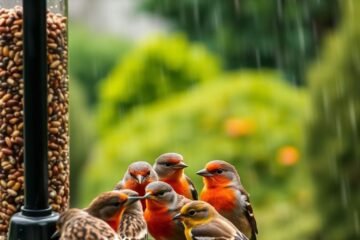
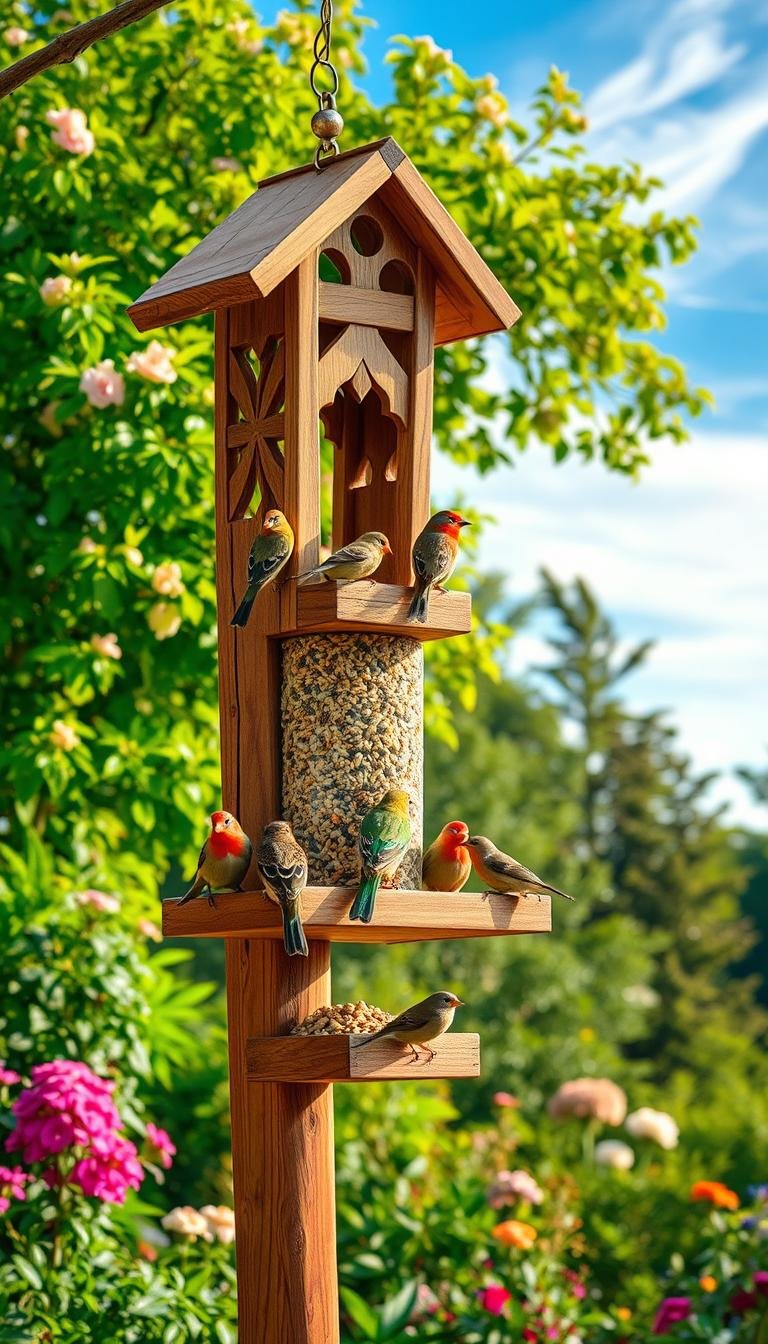

0 Comments